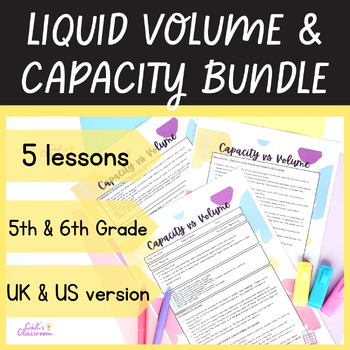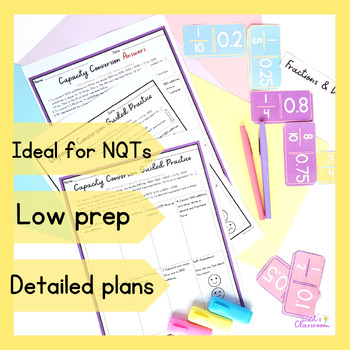Volume and Capacity│Liquid Measurement Activities│Lessons│Worksheets│5-Day Unit
- Zip
Products in this Bundle (5)
Bonus
Also included in
- 5th/6th grade end of year math fun! Preparing to teach metric weight and capacity? From liters and milliliters to tons and kilograms, this unit features hands-on measurement games/activities, digital/printable resources and detailed lesson plans.Designed specifically with newly qualified teachers inPrice $29.70Original Price $45.68Save $15.98
Description
5th/6th grade end of year math fun! Looking for a complete unit on liquid volume and capacity measured in liters and milliliters? Want it to include step-by-step lesson plans, hands-on measurement activities, digital presentations/software, engaging games and practice worksheets? Then this resource is for ✨️YOU!✨️
Designed specifically with newly qualified teachers in mind, this comprehensive resource is your go-to solution for planning curriculum-aligned, engaging maths lessons. ✏️
Teach the following topics without the stress of creating everything from scratch:
⭐️Estimating, selecting and justifying appropriate units of capacity measurement.
⭐️Measuring, comparing and ordering liters and milliliters in fractional/decimal form.
⭐️Converting between liters and milliliters.
⭐️Understanding the difference between liquid volume and capacity.
⭐️Using Microsoft Excel/Google Sheets to increase liquid volume for real life purposes.
⏰️ Say goodbye to endless hours of searching for resources—our bundle is here to save you time and energy while ensuring your students excel in the classroom. Grab your copy NOW!
This unit aligned with both CCSSM and the Irish Primary Mathematics Curriculum (2023) and contains UK and US versions for appropriate spelling.
It also includes two BONUS resources: 1 weekly overview and 1 weekly planning grid for seamless planning and preparation! ✍️
⭐️Benefits⭐️
✅️Saves valuable preparation and planning time by streamlining your planning process.
✅️Offers a print-and-go, low prep format for convenience with step-by-step instructions.
✅️Ideal for newly qualified teachers who want support teaching maths to 5th/6th grade.
✅️Offers digital learning opportunities, fostering engagement and deeper comprehension of volume and capacity concepts in the digital age.
✅️Enhances student understanding in an interactive, hands-on way.
✅️Fosters teamwork skills through group work activities.
✅️Simplifies learning, making it engaging and accessible for your students.
✅️Enhances mathematical proficiency through increasing conceptual understanding and procedural fluency.
What's Included in Each Lesson? ⏬️
- 3 learning objectives: Clearly defines lesson outcomes, guiding both teachers and students in their learning goals.
- Differentiation strategies: Accommodates diverse learning needs, ensuring all students can access and succeed in the lesson.
- Assessment strategies: Provides practical guidance on assessing student understanding throughout the lesson.
- Key vocabulary and definitions: Equips students with essential language for effective communication about liquid volume and capacity concepts.
- Math Talk digital presentation: Stimulates mathematical discourse and facilitates classroom discussions.
- Exit tickets (color and black & white): Quickly gauges student understanding at the end of the lesson, providing valuable feedback for future instruction.
What's Included in Individual Lessons? ⏬️
⭐️Lesson 1: Units of Capacity Math Lesson Plan │Hands-On Activities/Worksheets│5th/6th Grade
- Capacity Unit Sort and Match game cards: Promotes hands-on learning and reinforces understanding of capacity units.
- Estimation Station worksheets (color and black & white): Develops estimation skills, enhancing mathematical reasoning.
- Problem-solving scenario worksheets (color and black & white): Challenges students' critical thinking with real-life scenarios, fostering problem-solving abilities.
⭐️Lesson 2: Comparing Capacity Math Lesson Plan│Hands-on Activities & Worksheets│5th/6th Grade
- Capacity Card Game (4 sets of 6 cards): Enhances understanding of capacity in liters and milliliters through interactive gameplay, promoting engagement and retention.
- 1 group worksheet (color and black & white): Fosters collaborative learning as students work together to measure, order, and compare capacities, encouraging peer interaction and discussion.
- 1 individual worksheet (color and black & white): Provides independent practice in ordering, and comparing capacities, allowing students to demonstrate their understanding individually.
⭐️Lesson 3: Converting Capacity Math Lesson Plan│Hands-on Activities & Worksheets│5th/6th Grade
- Equivalent fractions & decimals dominoes game (24 dominoes): Reinforces fractions and decimals concepts in a fun and interactive way, preparing students for the lesson's focus.
- 2 capacity conversion charts (color and black & white): Provides visual reference tools for students to easily convert between liters and milliliters.
- Capacity conversion guided practice worksheet & answer key (color and black & white): Offers structured practice exercises, allowing students to reinforce their capacity conversion skills.
- 6 problem-solving scenarios & answer key: Challenges students to apply their knowledge in practical contexts and fostering critical thinking skills.
- Problem-solving worksheet (color and black & white): Provides space for students to solve capacity conversion problems.
⭐️Lesson 4: Capacity VS Liquid Volume Math Lesson Plan│Hands-on Activities & Worksheets│5th/6th Grade
- 5 liquid volume and capacity riddles + answers: Engages students in critical thinking and problem-solving.
- Group worksheets for hands-on measurement activity (color and black & white): Promotes collaborative learning, encouraging peer interaction and teamwork.
- 1 Individual problem-solving scenario worksheet and answer key: Provides individual practice in applying knowledge of volume and capacity through real-world problem-solving scenarios.
⭐️Lesson 5: Increasing Liquid Volume Math Lesson Plan│Excel/Google Sheets Activity│5th/6th Grade
- Recipe scaling mind map template (color and black & white): Facilitates visual organization and understanding of the real world context behind the main activity.
- Fruit punch recipe (color and black & white): Provides a practical context for students to apply recipe scaling concepts, allowing them to practice increasing liquid volume amounts.
- Microsoft Excel teacher example and student workbook (imports directly to Google Sheets): Offers comprehensive guidance and hands-on practice in using Microsoft Excel or Google Sheets for recipe scaling.
- 2 Step-by-step guides for struggling students: Provides additional support and scaffolding for students who may require extra assistance using digital software.
❗️Other Uses❗️
- Utilize individual lessons as standalone resources: Each lesson plan within the unit can be used independently to teach specific concepts related to liquid volume and capacity. Teachers can select and adapt individual lessons to suit their curriculum needs or time constraints, allowing for flexibility in lesson planning.
- Extend learning beyond the classroom: The digital presentations, worksheets, and problem solving cards included in the unit can be assigned as homework or independent study tasks, allowing students to reinforce their understanding of liquid volume and capacity concepts outside of the classroom environment. This promotes self-directed learning and provides opportunities for further practice and review.
- Integrate cross-curricular activities: The unit's focus on real-world applications of liquid volume and capacity, such as using Microsoft Excel or Google Sheets for recipe scaling, provides opportunities for interdisciplinary learning. Teachers can incorporate elements of technology, science, and home economics into their math lessons, enriching students' learning experiences and fostering connections between different subject areas.
➡️ Elevate your teaching experience and engage your students - secure your complete liquid volume and capacity bundle TODAY! ⬅️
More 5th/6th Grade Bundles:
⭐ Volume of 3D Shapes│5-Day Unit│Lesson Plans Worksheets Games Activities 5th/6th
⭐ Measuring, Calculating and Converting Area/Surface Area in Metric Units Bundle
⭐ Metric System: Units of Weight Measurement Lesson & Activity Bundle 5th & 6th
⭐ Metric System: Units of Length Measurement & Perimeter Bundle (5th & 6th Grade)
⭐ Metric System: Area, Length and Perimeter Bundle (Measure, Calculate & Convert)
Click here to join the Cáit's Classroom mailing list for valuable tips, tricks, and special offers designed to support newly qualified teachers in effectively teaching maths to 3rd-6th grade students.






